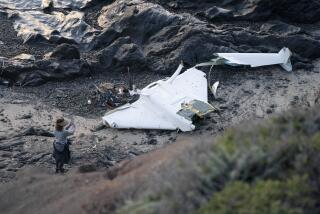Safety Board to Caution Pilots About Abrupt Rudder Motion
- Share via
WASHINGTON — Federal investigators probing the crash of the American Airlines jetliner whose tail broke off in November are expected to caution pilots against making sharp rudder movements in flight, government and industry officials said Wednesday.
The safety recommendation from the National Transportation Safety Board is expected to apply to all pilots, not just those flying Airbus A300 jets like the one that crashed in New York, killing all 260 people aboard and five on the ground.
Officials have not determined why Flight 587’s tail snapped off. Several sources said that information developed during the investigation had raised concerns that sharp rudder movements could, in certain circumstances, place excessive stress on a jet’s tail.
The crash is the first in decades of jet flight in which an airliner’s tail has broken off for no readily discernible reason. Investigators have not ruled out a structural flaw or a defect in the composite material used to build the A300’s tail.
“I can’t imagine that sharp rudder movements would snap off a tail unless there was something already wrong with that tail,” said Lew Aaronson, a retired Continental Airlines pilot.
Veteran pilots are skeptical that rudder motion alone could break the 27-foot vertical tail fin. The rudder is a movable panel on the rear edge of the fin that helps to steer a plane and keep it flying straight.
Federal investigators say that Flight 587 flew through the wake of a larger plane shortly before its pilots lost control. It then underwent a rapid series of side-to-side movements, two to the right and one to the left. Readings from the plane’s flight data recorder showed that the rudder moved in tandem.
Investigators have not been able to determine whether one of the pilots commanded those rudder movements or if they resulted from a mechanical malfunction or from the tail wobbling before it broke off. No evidence of engine failure has been found.
The rudder would not normally have been used to counteract wake turbulence, veteran pilots say.
To steady a plane in turbulent air, pilots usually employ the ailerons, movable panels on the wings that are used to turn an aircraft in flight. In a modern jetliner, the rudder is chiefly controlled by a computer, which makes constant small adjustments that help keep the plane flying straight.
“Frankly, pilots never use a rudder aggressively, even when needed,” said Barry Schiff, a retired TWA captain and aviation safety consultant. “Rudder inputs are small, and you only use them for engine failure and crosswind landings and takeoffs. Otherwise, pilots never do what the NTSB is cautioning them not to do, so it’s kind of a hollow suggestion.”
Late last month, Aviation Week published its own engineering analysis, which showed that sharp rudder motions could create forces that exceed the design limits of the tail fin under certain unusual conditions. The magazine said the critical condition occurs when the rudder is applied to counteract a sideslip, or sideways skid. “The rudder went haywire and the fin came off,” the magazine said.
Without commenting on the magazine’s findings, federal officials say that their own investigation has raised similar concerns.
“There are certain conditions that pilots may not be aware of that warrant an immediate safety recommendation,” said a source familiar with the investigation.
An industry official said current safety standards do not address the forces that could be created by sharp back-and-forth rudder movements, since it would be highly unusual for pilots to take such actions in flight.
The official said the NTSB recommendation is likely to prompt added cautions in pilot training, as well as an examination of design standards by aircraft companies such as Boeing Co. and Airbus Industrie, the European manufacturer of the plane that crashed.
More to Read
Sign up for Essential California
The most important California stories and recommendations in your inbox every morning.
You may occasionally receive promotional content from the Los Angeles Times.













